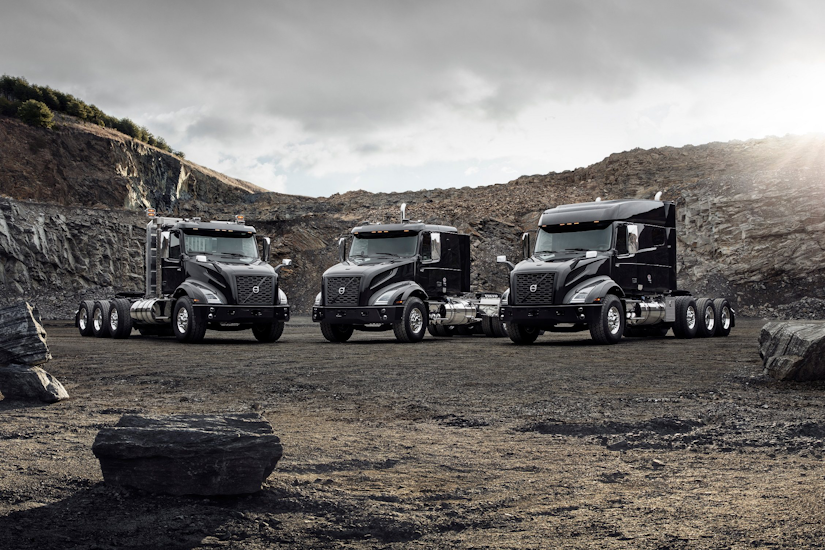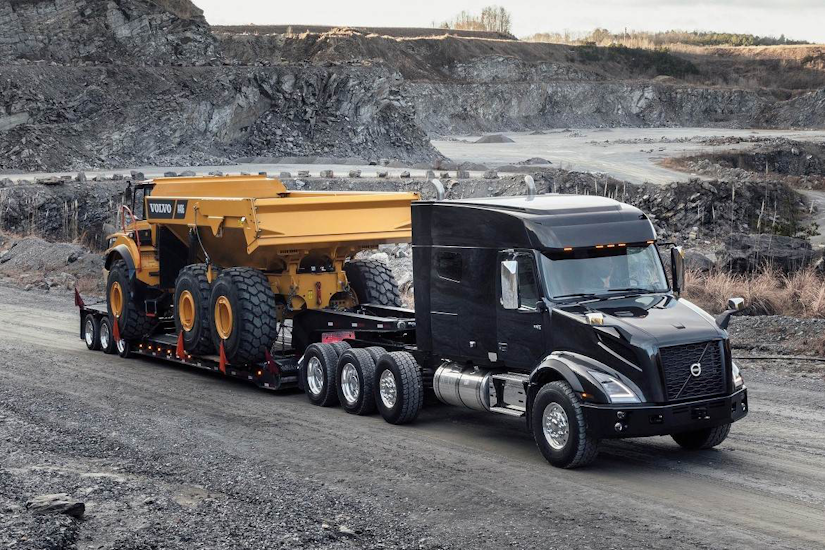
The new Volvo VNX series heavy haul trucks can pull up to 225,000 pounds with a 605 horsepower/ 2,050 ft.-lb. torque engine.
Low, gray skies. Snow on mountains. Flurries dancing through the icy air—it was a backdrop made to order for the launch of Volvo’s redesigned VNX heavy-haul truck line. But the gloomy Nordic weather, wasn’t in Sweden (Volvo’s home base), but Dublin, Virginia, where the company has its assembly plant and North American customer center.
The man-against-the-elements tone of that chilly morning only highlighted what these trucks are designed for. With their big engines, rugged transmissions and beefy frames, the new VNX Series are made to haul things like construction machines, quarried granite, B- and C-trains hauling logs and gravel, and heavy tankers.
Hammer down the accelerator pedal on one of these spec’d-to-the-max VNX trucks and you can tap into 605 horsepower and 2,050 lb.-ft. of torque to pull 225,000 pounds. If these trucks can’t haul it, your next choice is a locomotive.
Cabs for every need
“There are no typical applications in the heavy-haul market,” says Chris Stadler, product marketing manager. Accordingly, Volvo designed three cab configurations that can take you across town or across a continent. The cabs include:
- The VNX 300, a simple daycab for local heavy haul.
- The VNX 400, a sleeper with a flat roof and 42 inches of space behind the seats for occasional overnights or when you run out of drive time on your hours of service.
- The VNX 470, designed for customers pulling heavy-haul, cross country duty and has all storage, amenities and comfort 70-inch sleeper including refrigeration, microwave and TV.
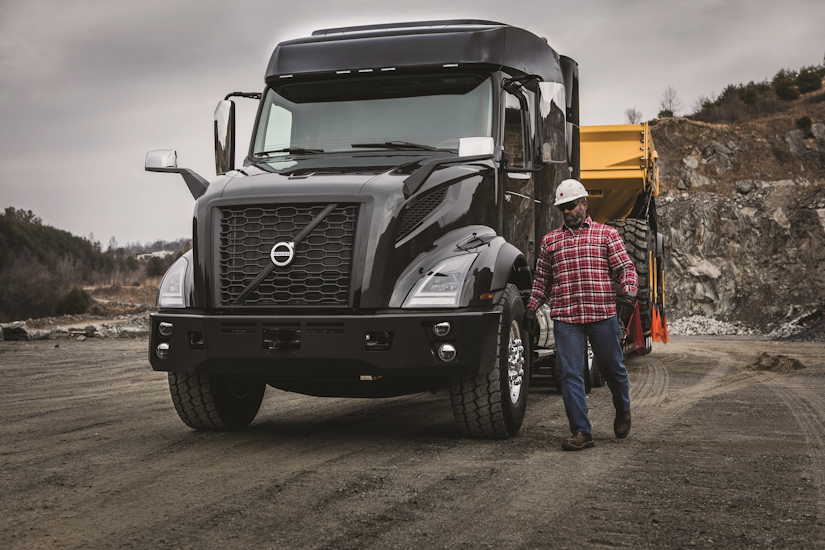
An aggressively sloped hood improves visibility. Also notice the widened fender flares which accommodate bigger tires and cut down on splash back.
With the new Electronic Logging Device mandate, hours of service regulations can force a long-haul driver with construction materials or machinery to stop in mid-job for up to eight hours, says Stadler. In these situations, it’s important to give drivers a safe and comfortable space to sleep or rest. Additionally, there are some heavy haul loads that for security purposes have to remain under supervision by the driver. If you have a load with these security requirements going across country, you need a sleeper cab, like the VNX 470, that can accommodate a driver for up to a week, he says.
Heavy specs
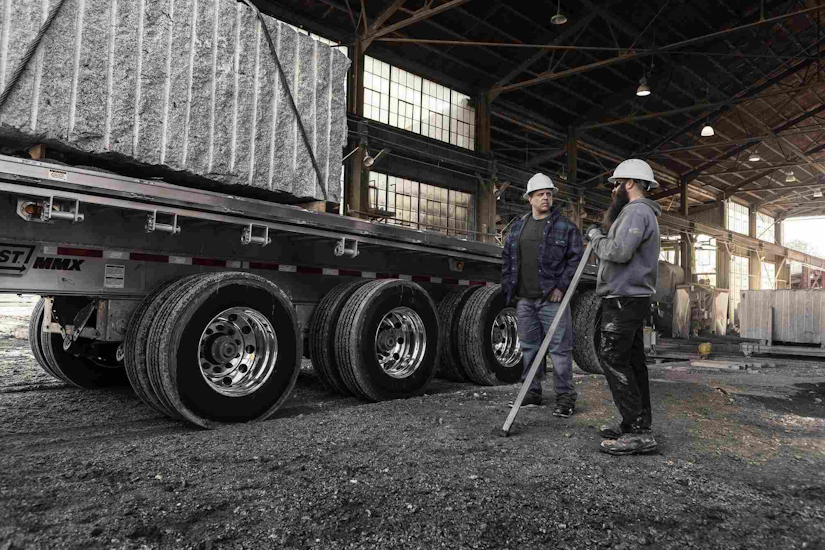
Frames were beefed up with 0.44 inch thick/120,000 pound psi steel to hold up under the weight of things like a pair of 50,000 pound granite blocks.
On the lighter end of things, VNX starts out with an approved gross combination weight rating (GCWR) from 125,000 to 160,000 pounds. With application approval and the appropriate components you can upsize that to 225,000 pounds. And you can distribute that weight with a wide range of optional steer axles, lift axles, tridem drive axles and longer fifth-wheel slides.
Front axles can be shod with upsized 445 tires and offer capacities from 16,000 to 20,000 pounds using parabolic springs. Rear axle specs run from 46,000 to 55,000 pounds and you can also get a premium rear heavy-haul suspension up to 52,000 pounds. Axle configuration choices include 6×4 tandem, 8×4 tandem, and 8×6 tridem configurations.
Dual steering gears insure that the driver maintains control of these heavy loads and long trailers on the road. And Volvo increased the ride height and ground clearance to 12 inches to accommodate more articulation and front ramp angle. The front bumper is aluminum to prevent rust and corrosion when it gets the inevitable nicks and dings. Built into the bumper is a tow pin with a 60,000-pound capacity, and the center tow frame evenly distributes towing forces through the chassis.
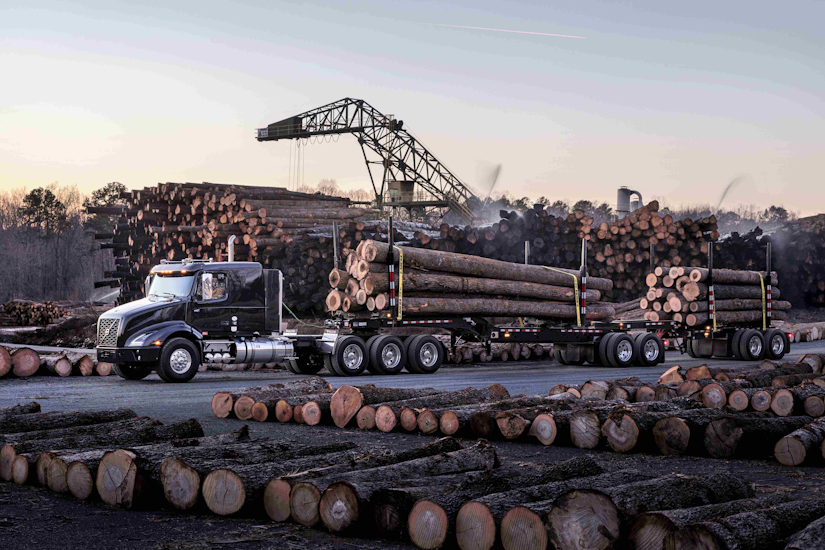
Heavy-haul weight distribution can be managed with a variety of axles including 6×4 tandem, 8×4 tandem, and 8×6 tridem configurations.
Heavy haulers like these wouldn’t last long without beefy frame rails. Volvo equipped the VNX series with 0.44-inch-thick steel frame rails rated to 120,000 psi.
Special attention was also paid to the maneuverability of the VNX line as well. The angle approach was improved up to 25 degrees and the fenders were extended to give you more clearance. Splash shields inside the fenders were also redesigned to deflect more water, mud and road grit. They’re also made out of a type of plastic that can survive rock impacts and temperatures down to 30 and 40 degrees Fahrenheit, which is what the heavy haulers working in the Canadian oil fields need.
Engines
Volvo offers two engines for the new VNX Series, a D13 Volvo engine and a Cummins X15 Performance Series. The D13 has two ratings: 500 horsepower/1,850 lb.-ft. of torque and 455 horsepower/1,750 lb.-ft. of torque. The Cummins X15, likewise has two ratings: 565 horsepower/1,850 lb.-ft. torque and 605 horsepower/2,050 lb.-ft. torque.
Updated from its 2014 design, the D13 offers a 2.5 percent boost to fuel efficiency. “By manipulating injection pressure, we save fuel and take stress off the system,” says John Moore, product marketing manager. “Reducing pressure also allowed us to put a single camshaft in and save 27 pounds of weight. We took another 50 pounds of weight out of the engine block, saving 77 pounds total.”
Volvo’s engine also uses what it calls a “wave piston design.” This patented piston shape improves in-cylinder combustion for an additional two percent fuel efficiency and reduces soot formation by up to 90 percent.
Transmissions
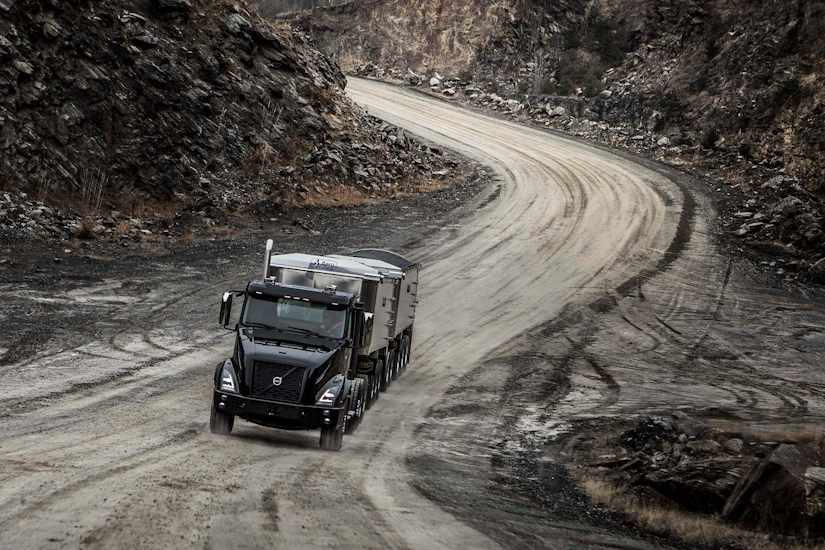
Automatic transmissions with ultra-low creeper gears give drivers confidence and security when hauling heavy loads up or down steep hills.
In the old-school past, manual transmissions may have been the choice for most heavy haul applications, but automatics and integrated transmissions are here to stay and can offer plenty of benefit in this market, says Moore.
Volvo equips its VNX trucks that have I-Shift trannies and the GHG17 engine with heavy haul software. “We’ve been using this in Western Canada with D13s and seeing excellent results,” says Moore. “It has better momentum management and keeps the torque high so there is very little break in the driveline because it shifts so fast. It maintains momentum up hill, and drivers like that. And you can turn it off with a button on the shifter and it goes back into the fuel efficiency mode,” he says.
At 135,000 GCVW the heavy haul software is standard with the HD package.
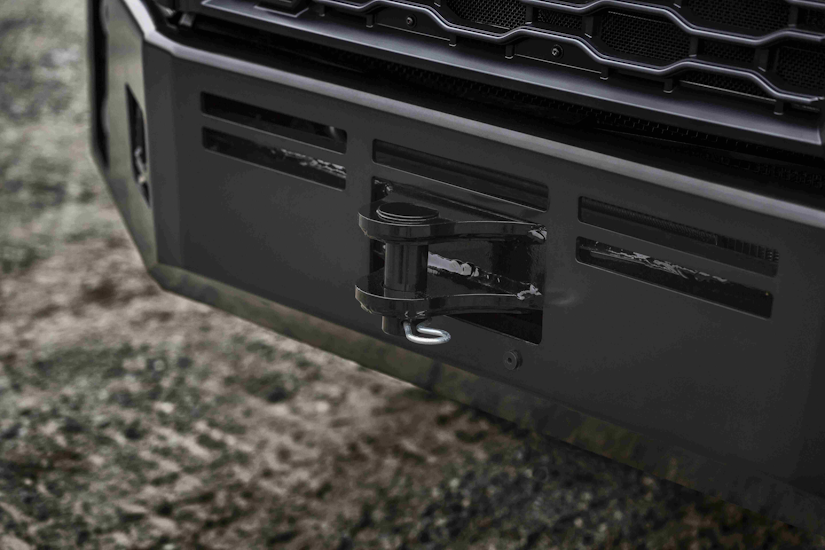
The tow pin is rated to 60,000 pounds and the aluminum bumper shroud avoids the rust and corrosion issues common to steel bumpers.
You can also toggle between two modes, straight torque and eco-torque, says Moore.
Straight torque delivers basic transient response when you’re on the throttle and driving a lot of hills and inclines. If you want better fuel efficiency on the flats and driving at highway speeds, choose eco-torque. With eco-torque, the first eight gears will give you high torque as you accelerate, and the next four gears, eight through 12, will range between high or low torque depending on the load on the engine. “For lightly loaded situations it will settle down and go to the low torque curve to save additional fuel,” says Moore. “And if you get on a grade, within a half a second, you’re automatically shifting back to the high torque curve.”
The I-Shift for severe duty offers a hardened main box and hardened gears, high viscosity oil to support frequent shifting, a hardened high-range cone, improved split synchronizer and increased clutch durability. Deep reduction creeper gears can get the speed down to 0.6 mph, improving low speed maneuverability, and steep hill startablity as well as preventing the truck from getting stuck in unfavorable ground conditions.
In addition to the Volvo I-Shift transmissions, the D13 engine can also be paired with Eaton Fuller 13- and 18-speed manual transmissions.
Cummins X15
The Cummins engine is also a new design. The company changed the turbos and improved air flow to get the 605 horsepower. And thanks to the improved air flow, air braking has been substantially improved. This is particularly important in heavy haul applications at low speeds.
The aftertreatment system on the Cummins has also been redesigned and is 50-percent smaller than the previous version. This saves weight and space and reduces installation complexities. If you choose the Cummins X15 option, you can mate it with Eaton Fuller 13- and 18-speed Ultrashift Plus automatic transmissions or Eaton Fuller 13- or 18-speed manual transmissions.
Driver comfort

Cabs were redesigned to put most needed controls within easy reach of the driver or on the steering wheel.
Cabs got a refresh on the new VNX trucks. The dash is arranged for easy-reach and at-a-glance controls with the most frequently used controls easiest to reach. The five-inch color monitor/infotainment display also works with steering wheel controls. On top the dash you’ll find a tray with multiple USB and 12-volt connections for phones and gadgets. The instrument cluster’s light green backlighting reduces eye strain.
Safety
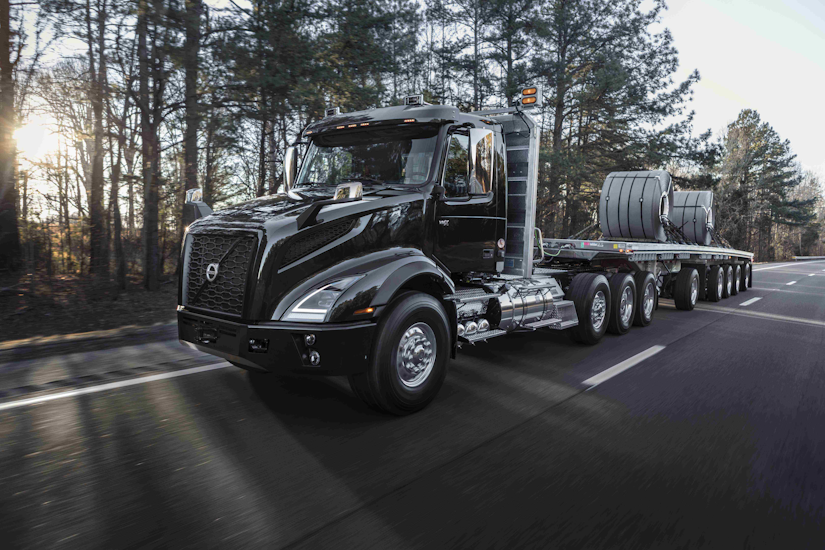
On flat roads at highway speed, Volvo’s heavy-haul software changes the engine parameters to a low-torque curve to save fuel. Hit an incline and it automatically changes back to a high torque setting.
The VNX series high-strength steel cab exceeds both the Volvo Swedish Cab Safety Test and ECE R-29 rollover requirements. A side airbag for the driver comes standard along with a seat-mounted rollover airbag. Volvo trucks also have an electronic system that detects imminent loss of control, jackknife, or rollover events and automatically reduces engine torque and applies braking to help the driver keep the truck on course.
Orders for the new VNX trucks are being taken now and production is slated to start in April.

